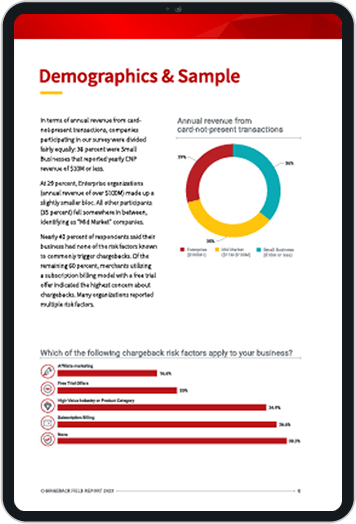Wire Fraud: How This White-Collar Crime Swindles Merchants, Banks, & Consumers
The gradual increase in electronic transaction volume is leading to a commensurate rise in fraud.
Scammers are well-aware that electronic transfers are the payment method of choice for high-value transactions. They’re exploiting vulnerabilities in payment rails to trick individuals and companies into transferring funds to unintended recipients.
How much of a problem is this?
Well, in 2022, the Internet Crime Complaint Center (IC3) received 21,832 complaints, with losses totaling over $2.7 billion, resulting from just one specific wire fraud tactic (business email compromise). Victims are also being targeted with tactics like spoofing, social engineering, and phishing, resulting in many billions more in losses.
To make matters worse, the financial losses are just the tip of the iceberg. Merchants who fall victim to (or otherwise fail to prevent) wire fraud may also lose customers, tarnish their reputations, or even face possible regulatory penalties.
In this article, I’ll discuss wire fraud and describe how scammers carry it out. I’ll also talk about why businesses fall victim to wire fraud and what you can do to protect yourself.
Recommended reading
- Credit Card Shimmers: Are You Prepared for “Skimming 2.0?”
- The Top 10 Prepaid Card Scams to Watch Out For in 2025
- How do Banks Conduct Credit Card Fraud Investigations?
- Fraud as a Service: How it Works | Examples | Detection
- How Triangulation Fraud Works | Red Flags & How to Prevent
- Coupon Scams | Common Tactics & High-Profile Examples
What is Wire Fraud?
- Wire Fraud
Wire fraud is a type of financial fraud where scammers use electronic communication, such as emails, phone calls, or the internet, to trick victims into initiating domestic or international wire transfers to unintended recipients. Fraudsters use cybercrime techniques like phishing, ransomware, identity theft, social engineering, and business email compromise scams to carry out wire fraud attacks.
[noun]/wī • ər • frôd/
Wire fraud is a pretty broad topic.
It covers any fraud involving the use of telecommunications or the internet. That means any fraud scheme carried out through email, phone calls, text messages, or online communications will qualify. The goal is to trick victims into wiring funds to accounts controlled by criminals.
It’s hard to trace and recover stolen funds because wire fraud operates across digital and financial networks. Scammers use sophisticated tactics, from spoofing emails to creating fake websites or hacking into legitimate accounts to appear credible.
Wire fraud is a federal crime in the US, carrying penalties including fines and imprisonment. But, the promise of a big payoff is enough for lots of scammers (and their accomplices) to take the risk.
Elements of Wire Fraud
Wire fraud occurs when a person intentionally devises a scheme to deceive someone for financial or material gain using interstate electronic communications such as emails, phone calls, or websites. To secure a conviction, prosecutors must prove the defendant acted dishonestly with intent to defraud and that the scheme involved and used interstate communications.
Wire fraud can cover a lot of different behaviors. So, what exactly counts?
Section 941 of the Criminal Resources Manual, part of the Department of Justice's internal Justice Manual, cites 18 U.S.C. § 1343 (2008) in putting together a four-element definition of wire fraud. Prosecutors must prove all four are present in order to secure a conviction for the crime:
- That the defendant voluntarily and intentionally devised or participated in a scheme to defraud another out of money
- That the defendant did so with the intent to defraud
- That it was reasonably foreseeable that interstate wire communications would be used
- That interstate wire communications were in fact used
In layman’s terms, an individual commits wire transfer fraud only when they deliberately acted dishonestly with the goal to deceive others. And, in fact, they made false promises, lies, or hid critical information to trick a victim out of money, property, or something else of value.
In addition, the individual must have expected to involve, and have actually involved, interstate electronic communications — such phone calls, emails, social media messages, or websites — when carrying out the fraud. A scheme that does not cross state boundaries would not be a federal offense.
That “interstate wire communications” clause is especially relevant when it comes to chargeback abuse. If a buyer deliberately engages in cyber shoplifting, it could be classed as a form of wire fraud, because it was conducted via interstate electronic communications.
Common Wire Fraud Tactics
Although fraud tactics are commonly evolving and may be difficult to anticipate, you can be on high alert for several common and “evergreen” tactics. These include:
Penalties for Wire Fraud
A defendant convicted of wire fraud under 18 U.S.C. § 1343 (2008) commits a federal offense that carries a maximum fine of $250,000 per violation and/or a prison sentence of up to 20 years.
If the defendant is an organization, rather than an individual, the maximum fine is doubled to $500,000 per offense. Courts may also order that the fraudster pay restitution to the victim, and/or forfeit the assets they gained illegally through the crime.
§ 2B1.1 of the Federal Sentencing Guidelines, a set of non-binding rules created by the United States Sentencing Commission (USSC), establishes more granular sentencing recommendations for offenders. A number of factors can be used to determine an exact sentence, including (but not limited to):
- The fraudster’s previous criminal record
- The loss involved
- The violations concurrently committed
- The victim of the crime
Notable Examples of Wire Fraud
Let’s be honest here: a lot of perpetrators of wire fraud will never face justice.
They might make it out with thousands — or even millions — in stolen proceeds. But, we do have some high-profile examples of scammers that got caught that we can point to.
The Tom Girardi Fraud Case

In August 2024, 85-year-old Tom Girardi, a former attorney and name partner of the now-defunct Girardi Keese, a Los Angeles-based law firm, was found guilty of four counts of wire fraud and embezzlement involving his clients’ settlement funds. During the trial, Girardi was revealed to have used $15 million worth of client funds to pay for personal expenses, including private jets and luxury cars. He also used the stolen money to fund his estranged wife Erika Jayne’s entertainment business.
His former chief financial officer, 51-year-old Christopher Kazuo Kamon, was also convicted of two counts of wire fraud. In his plea, Kamon stated that over a 10-year period spanning between 2010 and December 2020, he worked with Girardi to embezzle funds worth millions of dollars from the law firm’s hapless clients.
Kamon also admitted to embezzling the law firm’s funds for personal use. He managed to pull this off by working with co-conspirators who posed as vendors that sent fraudulent invoices to the firm for bogus goods and services.
The Arizona Couple Medical Scheme
39-year-old Alexandra Gehrke and her husband, 46-year-old Jeffrey King, ran a health care fraud scheme between November 2022 and May 2024 in Phoenix, Arizona.
Through their two sham companies, Apex Medical LLC and Viking Medical Consultants LLC, the couple used unqualified medical sales representatives to identify and administer unnecessary wound care on elderly patients.
Specifically, Gehrke instructed their representatives to order large amniotic wound grafts from specific distributors, even if the patients’ wounds did not necessitate such sizable grafts. Once the grafts were ordered, Gehrke would refer these patients to King’s company, who contracted with nurse practitioners to perform the grafting procedures. King instructed the providers to “suspend their own medical judgment and apply all grafts ordered by the sales representatives, even when medically unreasonable and unnecessary.”
During the trial, it was revealed that the graft distributors had paid Gehrke over $279 million in illegal kickbacks for the orders. The couple collectively submitted an additional $1.2 billion in reimbursement claims to federal and commercial health insurance programs for the grafting procedures.
In October 2024, Gehrke pleaded guilty to health care fraud and wire fraud. She agreed to pay $614 million in restitution and is facing a maximum prison sentence of 20 years.
King pleaded guilty to similar charges on January 31, 2025. He was ordered to pay $605 million in restitution and is likewise facing 20 years in federal prison. The couple also agreed to forfeit an additional $410 million in funds they fraudulently and jointly obtained.
The Florida “Mother Teresa” Case

41-year-old Johanna Garcia, known within her Florida community as “Mother Teresa,” pleaded guilty to running a $200 million Ponzi scheme between October 2020 and August 2021.
Garcia acquired the moniker “Mother Teresa” because her merchant cash advance business, MJ Capital Funding, purportedly generated annualized returns as high as 120% for investors.
No merchant cash advance service could sustainably support such spectacular returns without assuming significant credit risk, though. And, the company eventually made several bad loans that went unpaid.
To keep up the charade, Garcia’s business devolved into a Ponzi scheme in which she would use funds from new investors to cash out existing investors. She also siphoned off millions of dollars in profits, which she used to purchase luxury vehicles and luxury apparel.
The FBI and US Securities and Exchange Commission eventually caught wind of the operation and shut down MJ Capital Funding in 2021, but not before investors lost more than $90 million. Garcia, showing little remorse, quickly established a new fraudulent operation under a different name.
In December 2024, Garcia was handed a 20-year sentence in federal prison for one count of conspiracy to commit mail fraud and wire fraud.
How Do You Fall Victim to Wire Fraud?
Lack of awareness of fraud tactics, inadequate or nonexistent fraud detection measures, and weak internal control systems are some of the most common reasons businesses and individuals fall victim to wire fraud.
How to Identify & Prevent Wire Fraud Attacks
You have to educate yourself on the latest wire fraud tactics and implement the right preventative measures to counter them. This is the only way to mitigate fraud threats and block wire fraud attacks before they cause significant harm.
I recommend that you:
Use Automated Fraud Detection Tools
Sometimes, fraudsters may use sophisticated fraud tactics that can con even the most risk-aware individuals. You need multiple sets of eyes on the problem — both human and machine.
Combining fraud training initiatives for staff with automated fraud detection tools that use rules-based or machine learning techniques to identify anomalies can provide you with an extra line of defense against wire fraud.
Double-Check Transfer Details
Fraudsters will often attempt to withdraw funds obtained through wire fraud immediately, which makes recovering stolen funds difficult or even impossible. If you receive new details for a transfer, take your time to confirm the recipient’s identity and their bank account details.
When verifying details, communicate directly with the intended recipient using secure and encrypted messaging services. Don’t rely on email or instructions that were sent to you; always reach out to them to double-check.
In any case, refuse to immediately send funds, even if the fraudster pressures you to act. After all, urgency is a common fraud tactic, and you should be suspicious of any high-pressure pleas.
Enhance Fraud Prevention Measures
Enable multi-factor authentication to prevent unauthorized individuals from accessing your accounts. This ensures that even if a fraudster has your login details, they won’t be able to access your account without additional verification.
Additionally, use machine learning and AI to monitor all transactions, and detect and flag unusual transaction patterns. Redundancy is key here; the more mechanisms you have in place to detect fraudulent activity, the better your chances of intercepting an attacker.
Strengthen Internal Controls
Conduct regular audits so that you know how effective your prevention strategies are, and to confirm that all funds are accounted for.
Before sending high-value transactions, make sure there are at least two or more individuals sign off on the transaction. Delegate duties so that no employee is single-handedly responsible for the entire transaction cycle, and encourage your staff to use encrypted file transfer systems when sharing sensitive customer information in order to reduce the risk of data breaches.
Also, limit the number of employees or departments who have the authority to process wire transfers so as to minimize the risk of insider fraud.
Get Expert Help in Your Fight Against Fraud
As a diligent merchant, you’re constantly deploying fraud prevention tools and keeping up with best practices.
While this is a good start, it’s not a panacea against fraud: criminals are constantly working on new and complex techniques to steal your hard-earned revenue. Not to mention, it’s exceptionally difficult to stay ahead of fraudsters while working on your business at the same time.
At Chargebacks9111®, our customizable, mutli-layered fraud solution can help you defeat wire fraud, chargeback misuse, and other forms of transaction fraud. Reach out today for a free, no-obligation ROI analysis.
FAQs
Who is the most frequent target of wire fraud?
The most frequent targets of wire fraud are financial institutions, enterprise organizations, and individuals in the real estate sector.
Is wire fraud hard to prove?
No. While fraudulent wire transfers are hard to unwind, wire fraud itself is easy to prove. That’s because the crime often generates a paper trail of financial and electronic communication records, as well as victim statements, that demonstrate an intent to commit fraud.
How is wire fraud detected?
Wire fraud can be detected through automated monitoring tools that flag unusual transaction patterns like large transfers or transactions from or from high-risk geographies. To detect wire fraud, financial institutions also staff wire departments with human fraud analysts and wire processors who subject transactions to manual review.
Who commits the most frauds?
The Association of Certified Fraud Examiners’ 2024 study on occupational fraud reveals that most schemes are carried out by employees who have worked for an organization for a period of 1–5 years (45%), managers in an organization (41%), and employees working in the operations department (14%).
Is wire transfer fraud a felony?
Yes, wire fraud is a felony punishable by a fine (up to $250,000 for individuals or $500,000 for companies) and/or a prison sentence of up to 20 years.
How can you avoid being a victim of wire fraud?
You can avoid being a victim of wire fraud by double-checking and verifying account details before initiating a wire transfer, using secure and robust fraud detection and prevention software, and by refusing to give into high-pressure or social engineering fraud techniques.














